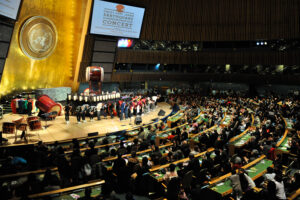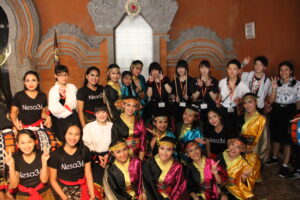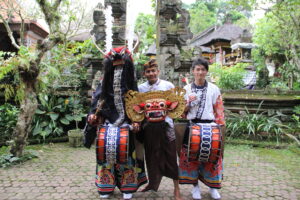2022.10.12
OTHERSSpiritual Recovery through Local Traditions and Culture: Overcoming the Disaster

The transnational collaborative performance and workshop “Genealogy of the Lion/Deer Dance” at the Sanriku International Arts Festival 2019. Japanese and Balinese local performing arts, which share the common aspect of lion/deer masks, were performed together. Photo: IDA Yuki
After a massive natural disaster, supporting steps by locals toward recovery and rebuilding communities can be as important as work done to repair buildings and infrastructure. The Japan Foundation has been working on “spiritual recovery” through traditional and cultural exchanges in areas where disasters and conflict have occurred.
The Great East Japan Earthquake occurred on March 11, 2011, causing extensive damage in Japan’s north-eastern Tohoku region. In the years that have followed this disaster, the Japan Foundation (JF) has implemented a wide range of reconstruction assistance projects in the area. Here, we would like to share how JF has been involved in the process of helping local residents connect with the world through international cultural exchange programs, using the traditional culture of the disaster-stricken areas as a source of support.
Since the earthquake and tsunami occurred, the devastation caused by the disaster has been conveyed to the rest of the world. Consequently, images of disaster may first come to mind to people outside of Japan, despite the natural richness of the Tohoku region. It was felt, not just by JF but by many people in Japan, that it would be better if we could promote the appeal of Tohoku in a more positive manner. JF held a series of discussions on what could be done, based on the two keywords of “culture” and “exchange,” as befits an international cultural exchange organization.

In 2012, Wakumizu Kagura and Ondekoza & Musicians gave a moving performance at the United Nations General Assembly Hall. Filling the huge venue with exhilaration, this concert was a great success, with standing ovations continuing long after the performance ended. Photo by Lee Wexler
In March 2012, JF organized a month-long comprehensive cultural program, “Overcoming the Disaster: Gratitude from Japan to the World,” which featured stage performances, exhibitions, lectures, films and documentary screenings and other programs about Tohoku and its recovery and revitalization. These were held in the U.S., France, China and other countries to express gratitude for the support sent to the area from all over the world. On stage, the kagura musicians, performing a style of traditional music passed down through generations in the Tohoku region, were joined by taiko drummers and other musicians from different genres to create a performance that conveyed the essence of Tohoku. Attending the performance at the United Nations General Assembly in New York—one of the venues where the event was held—then-Secretary-General Ban Ki-moon delivered the powerful message that the international community stands with Tohoku.
Exchange Programs for Youth with Experience of Similar Disasters
JF has long been involved in activities devoted to helping restore local community traditions and culture after disasters and conflict.
The year after Hurricane Katrina caused heavy damage to New Orleans in the U.S. in August 2005, JF dispatched experts who had played key roles in recovery work following the Great Hanshin-Awaji Earthquake of 1995. JF has continued to carry out dialogue-driven projects to share and pass on experiences. This accumulated know-how was immensely useful in the Great East Japan Earthquake reconstruction assistance project.
During fiscal 2012, JF implemented 10 new projects under the theme “Beyond March 11th—Uniting with the World.” Among these were exchange programs for young people from Japan and other countries with similar experiences of disasters, which aligned perfectly with the aspirations of the participants.
One such project was the Miyagi-New Orleans Youth Jazz Exchange. A month after the earthquake, the Swing Dolphins, a junior jazz orchestra from Kesennuma City, Miyagi Prefecture, deprived of its instruments by the tsunami, received new instruments from New Orleans. Since the city, known as the birthplace of jazz, and Japan had exchanges in the past, there were strong existing bonds. Based on this connection, in October 2012, a high school jazz band from New Orleans visited three disaster-stricken areas in Miyagi to support local residents through music. They also performed with local junior jazz bands. The following year, members of the Swing Dolphins visited New Orleans and reunited with their friends there to perform. Their mutual respect gave rise to harmonies in both music and in friendship.
Another project, the Minamisanriku-Chile Youth Music and Poetry Exchange, was an exchange of poems and stories by high school students who had personally experienced disasters. Students from Minamisanriku Town, Miyagi Prefecture, which was hit by the tsunami, and from Constitución, central Chile, which was hit by the devastating earthquake in February 2010, could share their own stories in workshops in Japan and Chile. Across the sea, youth from these two regions engaged in meaningful dialogue.
Projects Connecting Tohoku’s Sanriku Region with Asia through the Performing Arts
Furthermore, the JF Asia Center, newly established in 2014, implemented ongoing cultural exchanges between Tohoku’s Sanriku region and other parts of Asia. The Sanriku-Asian Network Project (SANPRO), which began in 2015, was one such exchange program. Performing artists from Southeast Asia were invited to Sanriku and local performing artists were sent from Sanriku to countries in Southeast Asia.

In 2018, seven young dancers selected from Shishi Odori groups from Iwate and Miyagi prefectures visited Bali, Indonesia. For about a week, they conducted exchanges with Balinese dance and gamelan groups. Photo courtesy of ONODERA Sho
Mr. ONODERA Sho, a resident of Minamisanriku and a preserver of the Gyozan-ryu Mitobe Shishi Odori deer dance, a traditional performing art passed down in the former Sendai Domain including Minamisanriku, visited Bali, Indonesia in 2018 as part of the SANPRO program.
Mr. Onodera, who was a vocational college student at the time, recounts his memories of that visit. “I performed the traditional Shishi Odori of Minamisanriku with students from the performing arts clubs of high schools in Miyagi and Iwate prefectures. I was in the fifth grade of elementary school when I started performing the dance. I couldn’t imagine that this dance, which originated more than 300 years ago and had only been performed within our local community, would ever leave Japan and be seen by people from other countries. As we were shown traditional Balinese dances and talked with the dancers, I realized something. Although the instruments and the tempo of the two traditional dances are different, the intention of the dances is the same: to drive away the evils that inhabit the land and to pray for people to live in happiness. I think that Sanriku and Bali are far away from each other and our cultures are completely different, but there is a commonality in our local dances. I would never have realized this if we hadn’t joined the exchange.”

Mr. ONODERA Sho (far right) participated in the Bali visit program. While there, he had the opportunity to learn local Balinese performing arts. He says that experiencing different performing arts enabled him to deepen his understanding of the Shishi Odori he performs. Photo courtesy of ONODERA Sho
Mr. Onodera says that his experience of participating in the exchange program has given him a new passion for the Shishi Odori. “The dance has continued for more than 300 years, undeterred by earthquakes, but some aspects of it such as its origin still remain a mystery. I’d like to unravel these mysteries, little by little, while continuing to engage in exchanges with communities in various regions. I also hope to communicate with children to create an interest in the dance, so that it will continue to be performed in the future.”
These exchanges between Japan and Asia were triggered by natural disasters but will lead to leaps forward in creating a new future for Japan’s local performing arts. JF intends to keep widely sharing the discoveries that emerge when people meet face-to-face.
【Related pages】
“Shunkan,” “Antigone,” “The Cherry Orchard,” Expanding the Circle of Excitement beyond Language Barriers
